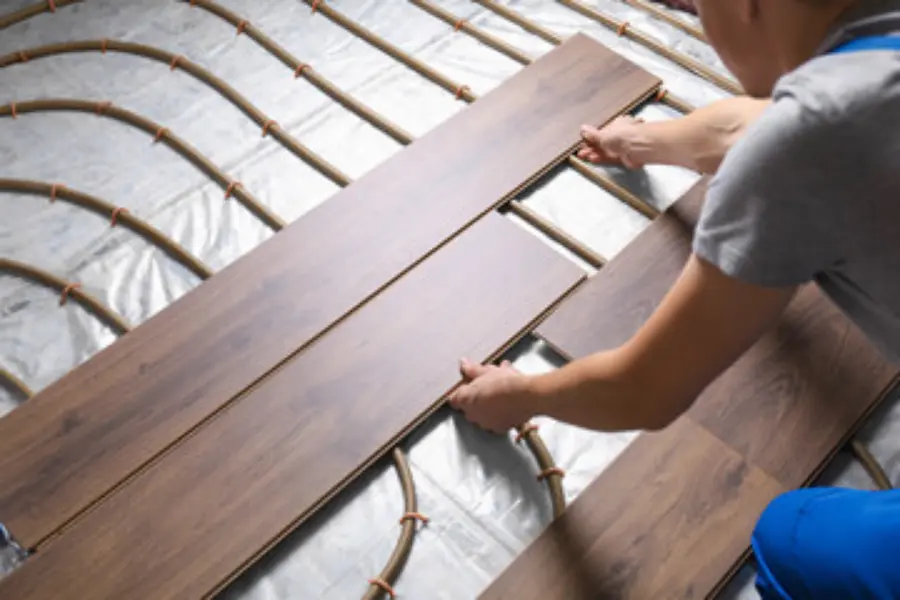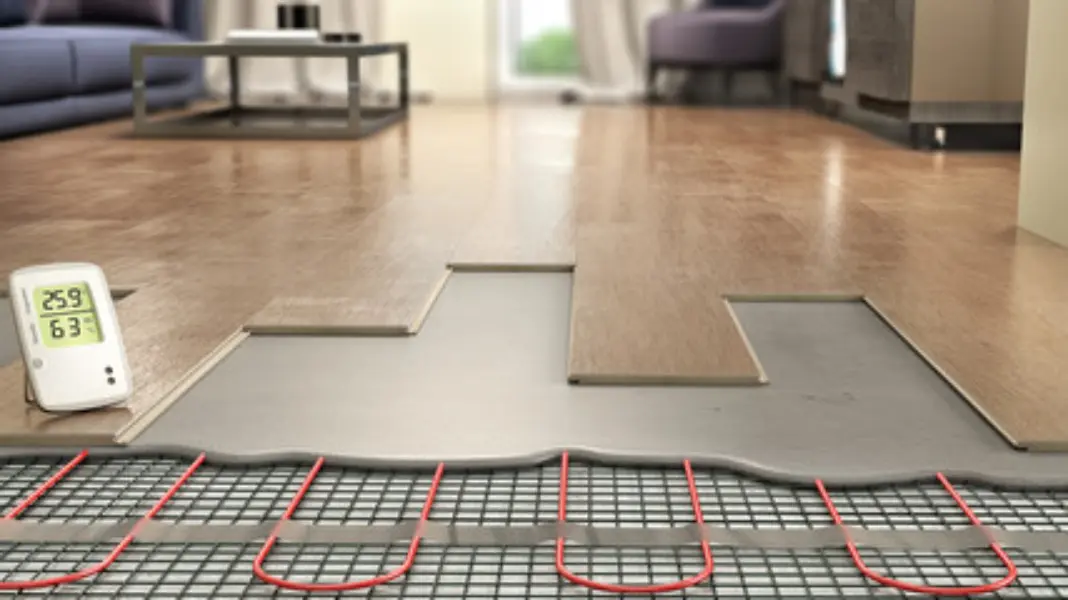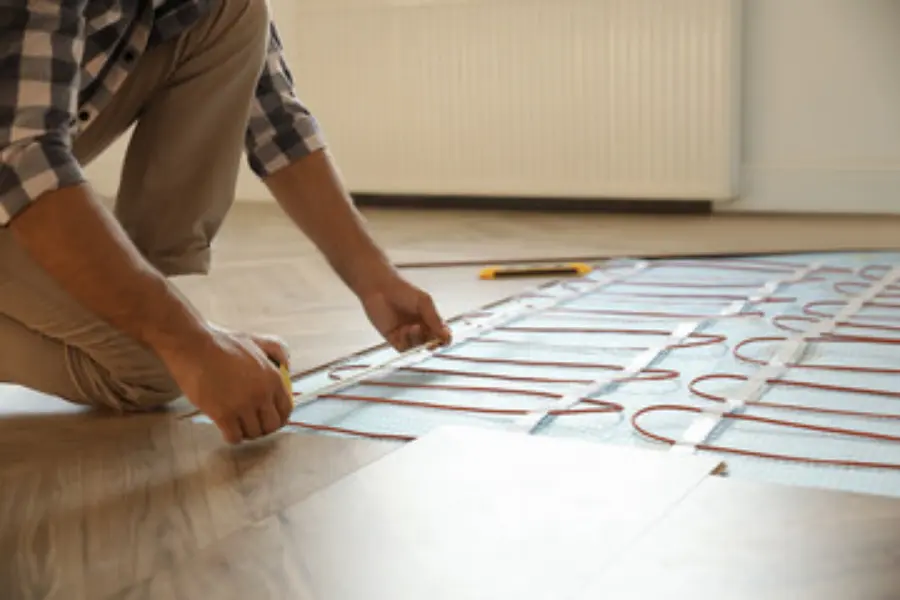Underfloor Heating Guide
Underfloor heating is an efficient, modern heating solution that’s becoming increasingly popular in both new builds and renovations. Suitable for a wide range of structures, including timber frames, solid floors, and joisted systems, it offers flexible options to match any building type.
This guide explores the essentials and provides you with the knowledge to select and install the right system with confidence.

How does underfloor heating work?
There are two types of underfloor heating, electric and warm water.
Electric underfloor heating works by using electrically conductive cables or heating mats placed beneath the flooring to produce warmth.
In comparison, the latter works by circulating warm water, at a lower temperature than radiators, through a network of pipes installed beneath the flooring.
Intelligent thermostats regulate and monitor the system, making sure a steady and comfortable temperature is maintained across the entire property, or area where underfloor heating is in place.
Is underfloor heating more efficient?
In terms of energy efficiency, yes! Conventional radiators require higher temperatures (65-75oC) to heat a room successfully, while underfloor heating can deliver the same comfort at just 29oC or below.
Radiators heat a room by warming the air, which can often result in ‘cold spots’, where it feels hot close to the radiator and cool in the middle. Whereas underfloor heating utilises radiant heat, providing even warmth and preventing stuffiness.
Fun Fact: Underfloor heating can cut energy use in a typical UK home by up to 35% due to its lower operating temperature and efficient heat distribution, helping to reduce energy bills.
Is underfloor heating worth it?
If you’re looking for a practical home investment that can also provide you with extra comfort, underfloor heating is a brilliant choice, particularly for smaller rooms or targeted home improvements. While it might not cut your energy bills by a dramatic amount, it can provide effective warmth, while adding a touch of everyday luxury.
Underfloor heating is also a worthwhile investment, particularly in bathroom renovations. The cost is reasonable, the comfort is immediate, and maintenance is virtually non-existent.
However, in terms of whole house heating, it can be more effective to prioritise broader energy-saving measures such as insulation, solar panels or heat pumps.
Underfloor heating works best as a complementary feature, a finishing touch rather than the primary heating source.
Is underfloor heating expensive to run?
Underfloor heating generally costs more to install than traditional radiators, but it’s often more energy efficient.
In a well-insulated home, heat is retained for longer periods, which means that although the initial investment may be higher, your ongoing energy costs can be reduced. This means greater savings over time.

How long does underfloor heating take to warm up?
The warmup time for underfloor heating depends on factors like subfloor insulation, flooring type, and whether the system is electric or water based. Overall home insulation, including windows, walls and lofts, also affects how quickly rooms heat up.
Can you have underfloor heating with carpet?
Underfloor heating can be used effectively with carpet, but a few important factors help ensure it performs at its best.
While thick carpets feel luxurious, they tend to slow heat transfer, so opting for a thinner, low-tog carpet is recommended.
The combined tog rating of the carpet and underlay should be 2.5 or less to allow heat to pass through efficiently.
It’s also worth choosing an underlay specifically designed for underfloor heating, as this can further boost energy efficiency.

Can you have underfloor heating upstairs?
Underfloor heating is suitable for both ground and upper floors, making it a great choice for new builds and renovation projects. The installation method varies depending on the construction of the upper floors.
How to install underfloor heating
Wet underfloor heating
Preparation:
Start by removing your existing flooring as this can take time so plan accordingly. Clear and clean the area and if needed, lay insulation and a damp proof layer before installation.
Installation:
- Connect the heating pipe to the manifold.
- Lay the pipework following your system’s manual, typically in a looping pattern for even heat distribution.
- Secure the pipes using staples.
- Once laid, have a professional check the insulation and make the final connection.
- Pressure test the system and ensure the pipes are filled with water.
- Pour self-levelling screed over the pipes, covering the entire area.
- Apply a chemical stabiliser to the screed.
- Tamp the screed for a smooth, even finish.
- Once cured, install your new flooring.

Dry underfloor heating
Preparation:
Remove your existing flooring and clear any debris. If needed, lay insulation and a damp-proof membrane to prepare the space.
Installation:
- Lay underfloor heating mats to cover the entire area for even heat distribution.
- Secure the mats with double sided tape.
- Install a floor sensor at a ground level and connect it to the thermostat, fixing it in place with tape.
- Call a qualified electrician to inspect the system and complete the final connection.
- Apply screed as described in the wet underfloor heating installation process.
- Once cured, lay your chosen flooring.

Underfloor heating offers a dependable, energy-efficient solution for both new builds and renovation projects. Designed to work with timber, solid and joisted floors, it’s a versatile choice that enhances comfort and adds value to any property. Selecting the right system and materials is key to a smooth installation and lasting performance, and we can help you get started!
If you have any more questions concerning underfloor heating, or you require any additional information about the underfloor heating services we sell at Howarth, please visit your local Howarth branch, or contact our customer services on 01472 907051.
Recent Posts
-
How to make your home more energy efficient
Every home can be greener but how do we make sure we are living in energy efficient homes? With risi
-
How do you prevent pipes from freezing?
Winter is an exciting time, with everyone looking forward to the incoming festivities. But with the
